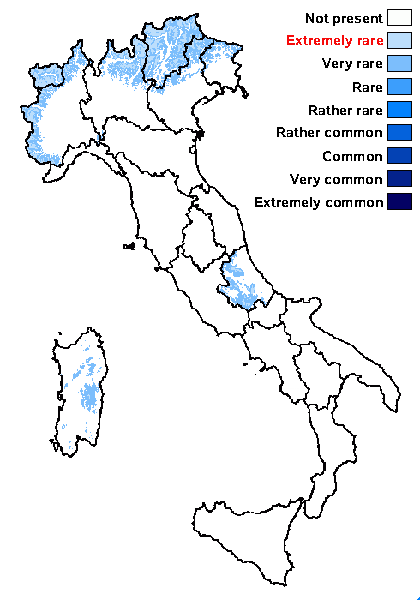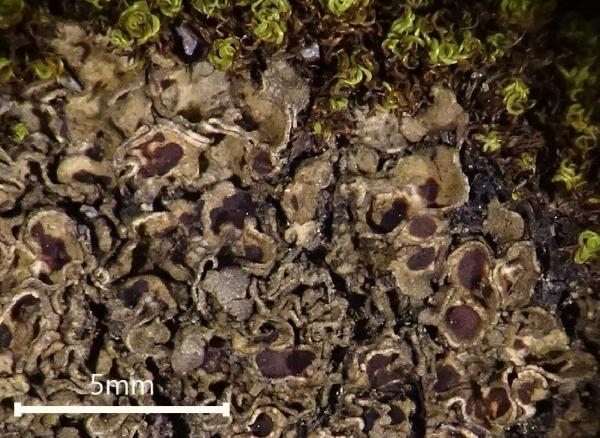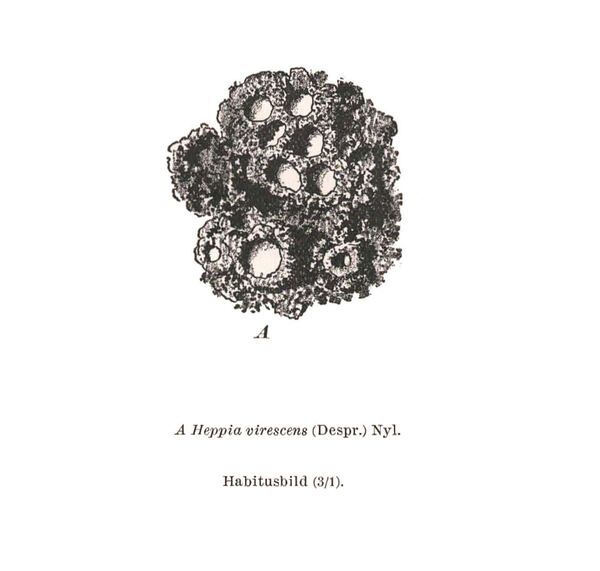Heppia adglutinata (Kremp.) A. Massal.
Geneac. Lich.: 8, 1854. Basionym: Lecanora adglutinata Kremp. - Flora, 24: 675, 1851.
Synonyms: Heppia monguillonii Harm.; Heppia urceolata Nägeli ex Hepp; Heppia virescens (Mont.) Nyl.; Nylanderopsis salevensis Gyeln.; Solorina virescens Mont.
Distribution: N - Frl, Ven (Nascimbene & Caniglia 2003c), TAA (Nascimbene & al. 2022, Pistocchi & al. 2024), Lomb, Piem (E.C.I. 568: Roux & Triebel 1994, Isocrono & al. 2003), VA (Piervittori & Isocrono 1999). C - Abr (Gheza & al. 2021), Sar (TSB 21722).
Description: Thallus squamulose, heteromerous, rather thick, olive-yellowish to ochraceous brown both when dry and when moist, with pale punctiform depressions in a reticulate pattern. Squamules subpeltate, 1.5-2(-3) mm broad, at first flat, then concave, contiguous, with rounded ends and a down-turned edges, attached by a mat of 10-14 µm thick, colourless rhizohyphae. Upper cortex paraplectenchymatous, (12-)25-50(-70) µm thick, of periclinally arranged hyphae, covered with a 7-12 µm thick epinecral layer; medulla poorly developed; lower cortex absent or restricted to the margins. Apothecia without a thalline margin, semi-immersed in the squamules, up to 2 mm across, with a dark reddish brown, concave to flat disc, and a thin to indistinct proper margin. Proper exciple 20-50 µm wide laterally; epithecium brownish, K-; hymenium colourless, 120-180(-195) µm high, K/I+ reddish; paraphyses mostly simple, lax, distinctly thickened above; hypothecium colourless, 20-35 µm high. Asci 8-spored, with a very thin wall disintegrating or opening by apical ruptures, Lichina-type. Ascospores 1-celled (sometimes apparently 1-septate), hyaline, ellipsoid, thin-walled, 20-23 x 7-8 µm. Pycnidia dark, immersed. Conidia fusiform, 2.5-3.5 x 1-1.5 µm. Photobiont cyanobacterial, Scytonema-like. Spot tests: K-, C-, KC-, P-, UV-. Chemistry: without lichen substances.Note: a cool-temperate to boreal-montane, circumpolar, ephemeral lichen of disturbed calciferous soil in dry, open grasslands; in the past it was frequently confused with the Mediterranean-Atlantic H. lutosa. An earlier record of this species from Sicily has been assigned to H. lutosa.
Growth form: Squamulose
Substrata: soil, terricolous mosses, and plant debris
Photobiont: cyanobacteria, filamentous (e.g. Nostoc, Scytonema)
Reproductive strategy: mainly sexual
Pioneer species
Commonnes-rarity: (info)
Alpine belt: extremely rare
Subalpine belt: very rare
Oromediterranean belt: extremely rare
Montane belt: very rare
Submediterranean belt: absent
Padanian area: absent
Humid submediterranean belt: absent
Humid mediterranean belt: absent
Dry mediterranean belt: absent

Predictive model
Herbarium samples

Source: Klepsland, J. T. 2020. Thirty lichens and lichenicolous fungi new to Norway. Graphis Scripta 32 (7): 120– 143. Oslo. ISSN 2002-4495. - CC BY-4.0
O L-227195

Collezione lichenologica Abramo Massalongo del Museo di Storia Naturale G. Ligabue di Venezia - Autori: Seggi, Linda; Trabucco, Raffaella Proprietà: Fondazione Musei Civici di Venezia - CC BY-NC
Italy, Veneto, In M. Alba ad terram 1855


Felix Schumm - CC BY-4.0
[VZR154], Insulae Canarienses, Tenerife. Las Montañas de Anaga,
Santa Cruz de Tenerife, Igueste, in valle Lomo de la Cruz, 300- 400 m.
Ad saxa eruptiva humida. Leg. A. Vezda. EX A. VEZDA: LICHENES
RARIORES EXSICCATI NR. 154.


Felix Schumm - CC BY-4.0
[VZR154], Insulae Canarienses, Tenerife. Las Montañas de Anaga,
Santa Cruz de Tenerife, Igueste, in valle Lomo de la Cruz, 300- 400 m.
Ad saxa eruptiva humida. Leg. A. Vezda. EX A. VEZDA: LICHENES
RARIORES EXSICCATI NR. 154.
Growth form: Squamulose
Substrata: soil, terricolous mosses, and plant debris
Photobiont: cyanobacteria, filamentous (e.g. Nostoc, Scytonema)
Reproductive strategy: mainly sexual
Pioneer species
Commonnes-rarity: (info)
Alpine belt: extremely rare
Subalpine belt: very rare
Oromediterranean belt: extremely rare
Montane belt: very rare
Submediterranean belt: absent
Padanian area: absent
Humid submediterranean belt: absent
Humid mediterranean belt: absent
Dry mediterranean belt: absent

Predictive model
| Herbarium samples |

Source: Klepsland, J. T. 2020. Thirty lichens and lichenicolous fungi new to Norway. Graphis Scripta 32 (7): 120– 143. Oslo. ISSN 2002-4495. - CC BY-4.0
O L-227195

Collezione lichenologica Abramo Massalongo del Museo di Storia Naturale G. Ligabue di Venezia - Autori: Seggi, Linda; Trabucco, Raffaella Proprietà: Fondazione Musei Civici di Venezia - CC BY-NC
Italy, Veneto, In M. Alba ad terram 1855


Felix Schumm - CC BY-4.0
[VZR154], Insulae Canarienses, Tenerife. Las Montañas de Anaga, Santa Cruz de Tenerife, Igueste, in valle Lomo de la Cruz, 300- 400 m. Ad saxa eruptiva humida. Leg. A. Vezda. EX A. VEZDA: LICHENES RARIORES EXSICCATI NR. 154.


 INDEX FUNGORUM
INDEX FUNGORUM
 GBIF
GBIF
 DOLICHENS
DOLICHENS






